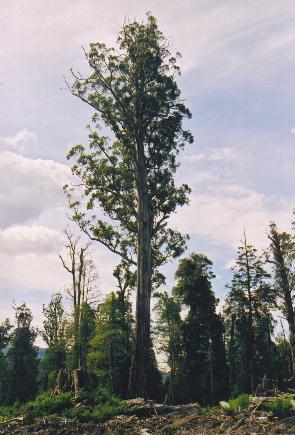El Grande (tree) on:
[Wikipedia]
[Google]
[Amazon]
 El Grande was a massive ''
El Grande was a massive ''
 El Grande was a massive ''
El Grande was a massive ''Eucalyptus
''Eucalyptus'' () is a genus of more than 700 species of flowering plants in the family Myrtaceae. Most species of ''Eucalyptus'' are trees, often Mallee (habit), mallees, and a few are shrubs. Along with several other genera in the tribe Eucalyp ...
'' (''Eucalyptus regnans
''Eucalyptus regnans'', known variously as mountain ash (in Victoria), giant ash or swamp gum (in Tasmania), or stringy gum, is a species of very tall forest tree that is native to the Australia states of Tasmania and Victoria. It is a straigh ...
'') in Tasmania
Tasmania (; palawa kani: ''Lutruwita'') is an island States and territories of Australia, state of Australia. It is located to the south of the Mainland Australia, Australian mainland, and is separated from it by the Bass Strait. The sta ...
and Australia
Australia, officially the Commonwealth of Australia, is a country comprising mainland Australia, the mainland of the Australia (continent), Australian continent, the island of Tasmania and list of islands of Australia, numerous smaller isl ...
's largest tree. It was located on a ridge in the upper Derwent valley, adjacent to the World Heritage Area of the Florentine Valley, approximately from Hobart
Hobart ( ) is the capital and most populous city of the island state of Tasmania, Australia. Located in Tasmania's south-east on the estuary of the River Derwent, it is the southernmost capital city in Australia. Despite containing nearly hal ...
. The tree stood in height, had a girth of , and a volume of 439 cubic metres. While it was not the tallest tree in Australia, it was considered to be the largest in terms of volume, and the world's biggest-stemmed flowering plant.
Approximately 350 years old, it was burned in April 2003, and died in December 2003, as the result of catching fire in a burn-off of the debris remaining after the clear-felling of old-growth forest
An old-growth forest or primary forest is a forest that has developed over a long period of time without disturbance. Due to this, old-growth forests exhibit unique ecological features. The Food and Agriculture Organization of the United Natio ...
in the tree's immediate vicinity. Australian forestry officials admitted responsibility for killing the tree. Its hollow trunk acted like a furnace so that it was cooked from the inside.
The death of the tree, which had already been used as a symbol in the Wilderness Society's campaign against logging, brought national and international media attention. The destruction of El Grande became a symbol for the destruction of Tasmanian forests. Scrutiny intensified the use of Tasmania's forests for wood chip exportation, and the processes involved.
In the later half of 2003, Forestry Tasmania decided to remove individual names from the state's giant trees, but later relented. Other giant trees in the area of El Grande which are also protected by Forestry Tasmania's Giant Trees Policy, have since been named Centurion
In the Roman army during classical antiquity, a centurion (; , . ; , or ), was a commander, nominally of a century (), a military unit originally consisting of 100 legionaries. The size of the century changed over time; from the 1st century BC ...
, which was discovered in 2008, and Triarius. Trees in the vicinity that had been named previously by the Wilderness Society include the Chapel tree and Gandalf's Staff.
See also
* List of the world's most largest tree species * List of the tallest tree species in the world *List of individual trees
The following is a list of individual trees. Trees listed here are regarded as important or specific by their historical, national, locational, natural or mythological context. The list includes actual trees located throughout the world, as we ...
References
{{DEFAULTSORT:El Grande (tree) Individual eucalypts Central Highlands (Tasmania) Tasmanian forests 2000s individual tree deaths Individual trees in Tasmania